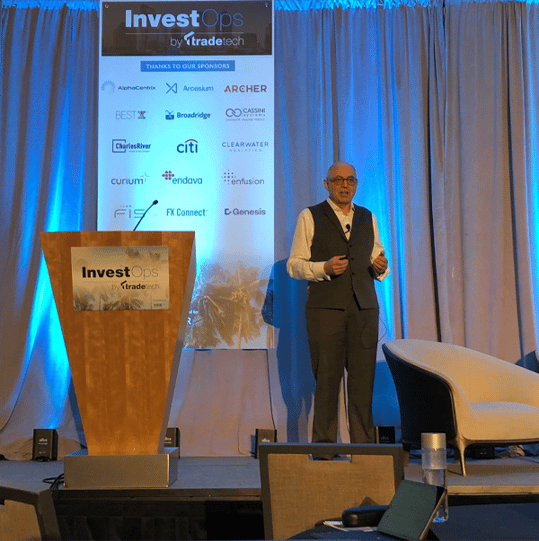Poor-quality data costs customers 22% of their growth | Gresham
What’s the average fee that funds charge customers to manage their money? 1.5%. On the surface, such a small percentage seems reasonable, insignificant even.
The same funds achieved an average of 6.6% growth for their customers in 2021. Do some basic maths, and suddenly that fee percentage doesn’t seem so reasonable after all. It amounts to a whopping (and shameful!) 22% of that growth your customers’ money has earned.
 Neil Vernon, Chief Technology Officer at Gresham, speaking to a crowd at InvestOps USA 2022
Neil Vernon, Chief Technology Officer at Gresham, speaking to a crowd at InvestOps USA 2022
Why do we think this is acceptable?
Put simply: It isn’t. And as digitisation creates a more transparent environment, customers will start asking questions. As an industry, investment managers will be held to account.
Why are funds charging this exorbitant cost?
Because they have no choice. The complexity of their infrastructures, the inefficiency of their operations, and their poor data quality make their businesses expensive to run.
What is driving these high operating costs?
The processing infrastructure for even a single financial product involves multiple layers of legacy technology and disconnected data and processes. At the same time, firms face constant pressure to deliver innovative new financial solutions. This creates an environment where uncertainty reigns and loss events are common.
Loss events are not limited to just financial impacts, although they are significant. The ORX membership base, which consists of just 81 banks, suffered a staggering €513 billion in total gross losses due to operational events between 2015 and 2020. But beyond this is the reputational damage – we’ve all seen firms hit the headlines through operational failure.
Why do loss events keep happening?
Has your firm built its own power station to cater to its specific needs? What about your own petrol refinery? Your own telco network?
Hopefully, you have not, for two good reasons:
- These services have become commodities since your firm’s needs are similar enough to its peers
- You simply don’t have the deep domain expertise required to build these utilities – and it would be a ridiculous waste of your highly-skilled teams’ valuable time to try
Case in point: Data Aggregation
A medium-sized buy-side firm takes in an average of 59 data feeds to drive different reconciliation and other operations functions. Those 59 feeds have no consistent standards and change frequently – without warning and in unpredictable ways.
Why would you want your skilled people to spend time on this task?
Not one buy-side firm could possibly justify managing data aggregation, normalisation, validation, and enrichment itself. As assets and data volumes grow, so does the number of people assigned to the task.
There are experts who operate such functions as a utility, who can aggregate the data you need, and manage it for you in a centralised location and respond to frequent changes and inconsistencies without the need for you to be involved at all.
The evidence is scale
Handing over the management of data architecture to specialists isn’t just about saving costs or maintaining a lean headcount. It’s about empowering your business to scale without having to hire more staff.
Unconstrained by poor data quality and manual processes, a major investment management firm we worked with doubled its total AUM in 1.5 years after automating its reconciliation and data aggregation through our Managed Services. By any means, this is an impressive level of growth. And they did it without adding headcount.
But it’s not the only success story.
Another global investment manager added $3.1 billion in AUM in just one year using our Data Services and automated solutions.
With operations and tech teams freed up to work on value-generating tasks, rather than struggling with complex new data challenges or scrambling to respond to critical events caused by data or process failures – growth is almost a given.
Regulators and customers care, too
Regulators have made it clear that they plan on scrutinising your data more closely than ever, as explained in our regulatory data integrity white paper.
But as I mentioned at the start, your customers who might have accepted this outrageous 22% loss of wealth in the past are going to start caring as well, and pretty quickly. That’s because they can see what is happening.
Consumer-based apps and digitisation are giving your clients a real-time view of their money and what’s happening to it. When the consequences of poor data and inefficient processes start showing up as errors, costs, and a lack of transparency, they are not going to like what they see.
Isn’t it time you took action?
Gresham will be at SIFMA Ops in Phoenix, May 16-18, 2022. Book an on-site meeting to learn more about how to get a better handle on your data, reconciliation, and fee billing operations.

